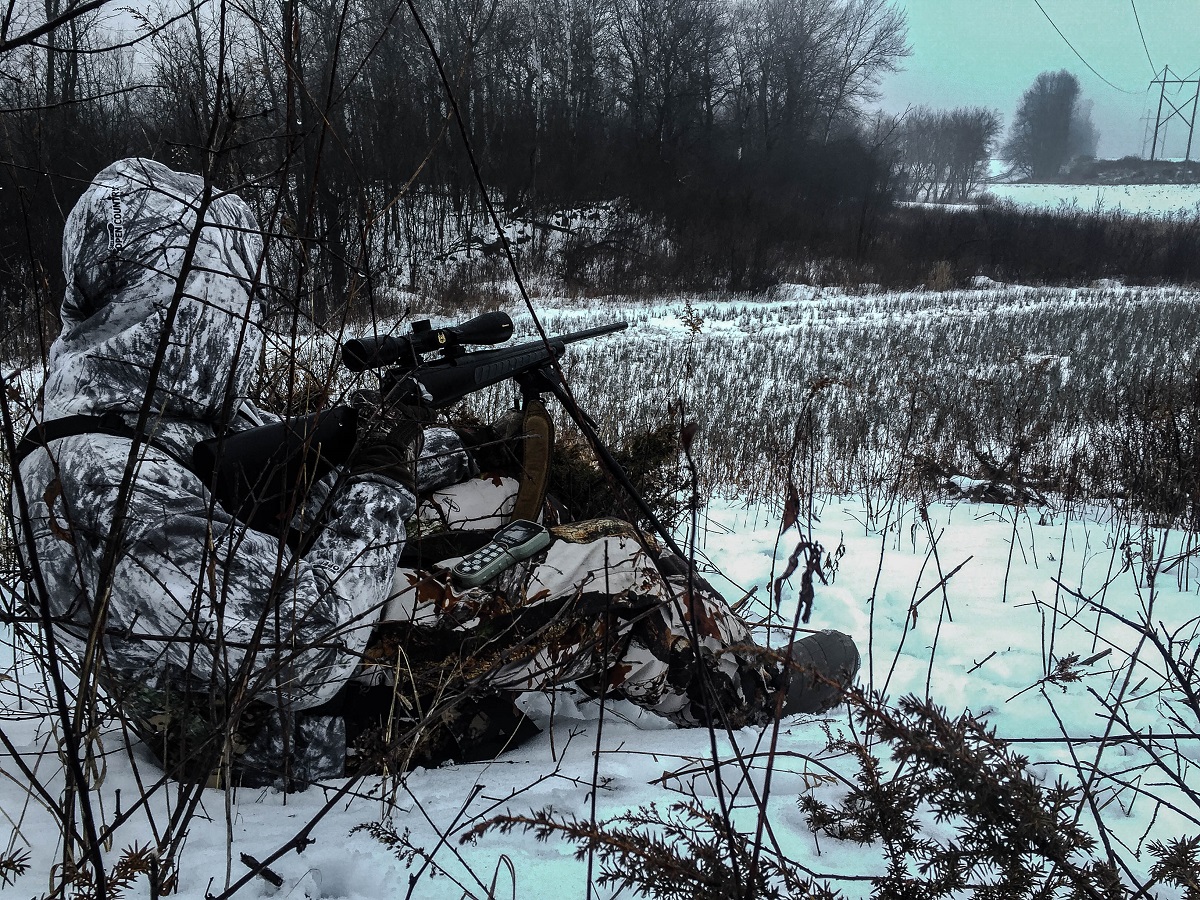I’ll be the first to admit that I’m no expert coyote hunter. However, my lack of success has yet to deter me from the sport, if anything it’s driven me to learn more about coyote hunting. For many of us, coyote hunting is a way to stay outdoors after the deer season has come to a close. Not only that, but we are also helping the local deer herd with any successful outing. Over the last couple years, my buddies and I have transitioned from rookies to what I would now call “intermediate” coyote hunters. The only way to continually hone your skills is to constantly learn from your mistakes and take the advice of better coyote hunters.
Here’s a short list of common mistakes made by novice coyote hunters and how you should go about improving upon them:
1 – Scout
When we first started giving coyote hunting a try, we would basically march into an area that looked like it would hold coyotes and set up. Typically, we would set up over a large field, frozen river, or basically anywhere we could see a couple hundred yards, set the call up, and wait. Nothing in the area said there were coyotes around other than it looked good. Empty trip after empty trip left us boggled.
 Coming across fresh coyote tracks in snow tells you that a dog is around. Now you just need to figure out the best way to call them in.
Coming across fresh coyote tracks in snow tells you that a dog is around. Now you just need to figure out the best way to call them in.
Years later, we rarely hunt any of those “good” looking coyote areas because there’s no sign of coyotes. If you don’t want to spend time scouting before your hunts you should take mental notes of where you see scat, tracks, dens, and coyotes themselves throughout the deer season. Shed hunting is also a great time to figure out where these wily creatures are spending their time. In the end, just remember you can’t kill what’s not there.
2 – Same Call, Same Results
This was and probably still is one of our biggest faults as intermediate coyote hunters looking to take the next step. Like many ‘yote hunters, our go-to call has always been the squealing rabbit. Why? I don’t know, because it sounds good??? That and maybe those darn western-state predator hunting shows that seem to have coyotes come in by the dozen.
While we’ve had minimal success with that call, we seem to rarely change it up. This year will be the year though… After reading many articles and blogs on coyote hunting in non-western states, it sounds like the dying rabbit is decent in the fall, but once these coyotes hear it a couple times they are much more cautious. A bird in distress, like a turkey or woodpecker, seems to be what the pros recommend. We shall see.
3 – Picked Off
Are coyotes spotting you before you’re spotting them? I guess we will never really know, will we? Perhaps our calling techniques are better than we thought, we just aren’t seeing them. Coyotes are very smart, especially when they’ve been avoiding deer hunters all season long. A lot of times, a coyote that’s on their way into a call will hang up on the edge of cover to survey things first. If he catches you moving or catches a whiff or your scent, you’ll never know they were there.
 A hunter wearing snow camo sitting on a hillside blends in seamlessly. Also note how the gun is shouldered at all times during the hunt to limit any unnecessary movement.
A hunter wearing snow camo sitting on a hillside blends in seamlessly. Also note how the gun is shouldered at all times during the hunt to limit any unnecessary movement.
It’s important to have your gun up and nearly shouldered as soon as you hit the call. Also, quality camouflage that blends in well with the surroundings is a must. We highly prefer hunting when there is snow on the ground because we blend in better and we can spot them sooner. Also, nearly every one of our sets is a two or three man set. Not only is it fun to hunt with friends, but another set of eyes and extra gun is extremely beneficial.
4 – Sit, Call, and Repeat
One of the things that makes coyote hunting so enjoyable is the fast pace style of hunting. There’s been a few times I’ve been discouraged after the first sit of the morning and called it a day. After all, we just spent the best time of day in our best area and got nothing, so why would we think the next set would be any different?
Because it’s hunting and you can’t kill them from your couch, that’s why! Instead of planning for one sit, plan on three. Like I said, coyote hunting is fast paced, if you don’t have any luck in 30 minutes, move on. This is where the next tip comes into play.
 Here’s an example of a mid-day coyote that was taken on our 5th set of the morning. The wireless call and motion decoy brought him in on a string.
Here’s an example of a mid-day coyote that was taken on our 5th set of the morning. The wireless call and motion decoy brought him in on a string.
5 – Piles of Properties
Have you ever heard any hunter say they have too much land to hunt? Doubt it, because there’s no such thing. With the fast pace style of coyote hunting, you’re going to need an ample amount of spots to rotate through. Coyote hunting is not like deer hunting in the sense that you can’t have three different spots to hunt on an 80-acre chunk. Why? Because the call effectively covers that entire area in just one sit, unless it’s really windy.
Solution: stack up as many properties as possible. It’s been our experience that far more landowners will allow you to hunt coyotes compared to deer. So even if you got rejected to hunt in fall, ask them again for permission to coyote hunt. Here are a few door-knocking tips that have gotten us permission on several hundreds of acres over the years.
In the end, keep it fun and look at any success as a bonus. Every area is different and coyote hunting is darn right difficult in most states. Stick with it and if something’s not working, don’t be afraid to change it up. After all, you can’t expect different results by doing the same thing.







